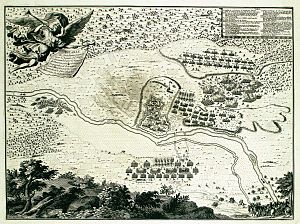Battle of Sinsheim
| date | June 16, 1674 |
|---|---|
| place | Sinsheim |
| output | French victory |
| Parties to the conflict | |
|---|---|
| Commander | |
| Troop strength | |
| 1–2 bags of infantry (800–1500 men) 48 Esk. Cavalry (6000 riders) 0 guns |
7 Btl. Infantry (3500 men) 48 Esk. Cavalry (6000 riders) 6 guns |
| losses | |
|
600-2500 men |
1500-2000 men |
Dutch War (1672–1678 / 79)
Solebay - First Schooneveld - Second Schooneveld - Texel - Bonn - Maastricht - Sinsheim - Seneffe - Enzheim - Türkheim - Sasbach - Konzer Bridge - Stromboli - Augusta - Palermo - Kokersberg - Philippsburg - Maastricht - Valenciennes - Tobago - Cassel - Freiburg - Ypres - Rheinfelden - Saint-Denis
The Battle of Sinsheim on June 16, 1674 was part of the Dutch War . Imperial and French troops met there. After a bitter battle, the French were victorious.
prehistory
In the early summer of 1674, the main imperial army under Alexander Duke of Bournonville and the troops of the Duke of Lorraine, Charles IV , who had been driven out by the French in 1670, tried to unite. Together they wanted to advance from the Rhine into Alsace in order to attack the French commander Turenne , who was operating there . This tried to prevent the unification of the opposing troops and set off from Philippsburg in the direction of the Neckar . At Sinsheim he met advance detachments of the Allies, whose main armies, however, were still separated. Turenne decided to attack in order to bring about a decision before the approach of Bournonville. Turenne's opponents were under the orders of the Duke of Lorraine Charles IV and the Imperial General Albert of Caprara . The troops of the allies consisted mainly of cavalry of Lorraine, Imperial and Saxon origin. In addition there were about 800 to 1500 infantry; There was no artillery.
course
The allies kept the town of Sinsheim and the gardens on the northern hills occupied. Elsenz , running south of the city, offered the advancing French an additional obstacle. Around ten o'clock in the morning Turenne formed his army for battle. After crossing the Mühlbach and Elsenz, the French conquered the Sinsheim Abbey and the city itself.
The attackers then formed two meetings at the foot of the hills, their own six guns positioned on the right wing. The Allies defended themselves tenaciously, but ultimately had to give in. By retreating, they managed to briefly retake the town of Sinsheim; but they were driven out of it after about two hours of house-to-house fighting. The subsequent regrouping of the French troops used the Duke of Lorraine for a cavalry attack, which was however repulsed. That decided the day around 5 p.m. in favor of the French.
consequences
The Allies withdrew north towards the Neckar. The attempt of the French to follow them through the wooded area failed. Turenne gave up the chase. The Allies marched on Heilbronn to unite with the main army under General Bournonville . This withdrew behind the Main to wait for further reinforcements. The battle is considered a first setback for the allies in the fight against the French. The French troops now began to devastate the Palatinate.
literature
- Gerhard Taddey (ed.): Lexicon of German history . People, events, institutions. From the turn of the times to the end of the 2nd World War. 2nd, revised edition. Kröner, Stuttgart 1983, ISBN 3-520-80002-0 , p. 1158.
- Gaston Bodart (ed.): Military-historical war lexicon. (1618-1905). Stern, Vienna 1908, p. 94 .
- Bernhard Poten (Hrsg.): Concise dictionary of the entire military sciences. Volume 9: Sievershausen to Zymotic Diseases. Velhagen & Klasing, Bielefeld et al. 1880, pp. 5-6 .
